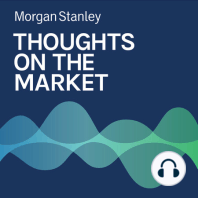3 min listen

Mike Wilson: The Increasing Risks to Earnings
Mike Wilson: The Increasing Risks to Earnings
ratings:
Length:
4 minutes
Released:
Aug 29, 2022
Format:
Podcast episode
Description
With Fed messaging making it clear they’re not yet done fighting inflation, the market is left to contend with the recent rally and prepare to adjust growth expectations.-----Transcript-----Welcome to Thoughts on the Market. I'm Mike Wilson, Chief Investment Officer and Chief U.S. Equity Strategist for Morgan Stanley. Along with my colleagues, bringing you a variety of perspectives, I'll be talking about the latest trends in the financial marketplace. It's Monday, August 29th, at 11 a.m. in New York. So let's get after it. After the Fed's highly anticipated annual meeting in Jackson Hole has come and gone with a very clear message - the fight against inflation is far from over, and the equity markets did not take it very well. As we discussed in this podcast two weeks ago, the equity markets may have gotten too excited and even pre traded a Fed pivot that isn't coming. For stocks, that means the bear market rally is likely over. Technically speaking, the rally looks rather textbook. In June, we reached oversold conditions with breadth falling to some of the lowest readings on record. However, the rally stalled out exactly at the 200-day moving average for the S&P 500 and many key stocks. On that basis alone, the sharp reversal looks quite ominous to even the most basic tactical analysts. From a fundamental standpoint, having a bullish view on U.S. stocks today is also challenging. First, there is valuation. As we have discussed many times in our research, the Price/Earnings ratio is a function of two inputs; 10 year U.S. Treasury yields and the Equity Risk Premium. Simplistically, the U.S. Treasury yield is a cost of capital component, while the Equity Risk Premium is primarily a function of growth expectations. Typically, the Equity Risk Premium is negatively correlated to growth. In other words, when growth is accelerating, or expected to accelerate, the Equity Risk Premium tends to be lower than normal and vice versa. Our problem with the view that June was the low for the index in this bear market is that the Equity Risk Premium never went above average. Instead, the fall in the Price/Earnings ratio from December to June was entirely a function of the Fed's tightening of financial conditions, and the higher cost of capital. Compounding this challenge, the Equity Risk Premium fell sharply over the past few months and reached near record lows in the post financial crisis period. In fact, the only time the Equity Risk Premium has been lower in the past 14 years was at the end of the bear market rally in March earlier this year, and we know how that ended. Even after Friday's sharp decline in stocks, the S&P 500 Equity Risk Premium remains more than 100 basis points lower than what our model suggests. In short, the S&P 500 price earnings ratio is 17.1x, it's 15% too high in our view. Second, while most investors remain preoccupied with the Fed, we have been more focused on earnings and the risk to forward estimates. In June, many investors began to share our concern, which is why stocks sold off so sharply in our view. Companies began managing the quarter lower, and by the time second quarter earnings season rolled around positioning was quite bearish and valuations were more reasonable at 15.4x. This led to the "bad news is good news" rally or, as many people claim, "better than feared" results. Call us old school, but better than feared is not a good reason to invest in something if the price is high and the earnings are weak. In other words, it's a fine reason for stocks to see some relief from an oversold condition, but we wouldn't commit any real capital to such a strategy. Our analysis of second quarter earnings showed clear deterioration in profitability, a trend we believe is just starting. In short, we believe earnings forecast for next year remains significantly too high. Finally, last week's highly anticipated Fed meeting turned out to be a nonevent for bonds, while it appeared to be a shock for stock investors. Iro
Released:
Aug 29, 2022
Format:
Podcast episode
Titles in the series (100)
Mike Wilson: Are U.S. Economic Indicators Flashing Yellow? by Thoughts on the Market